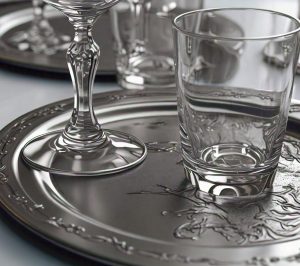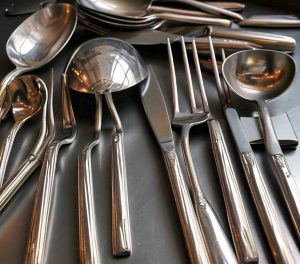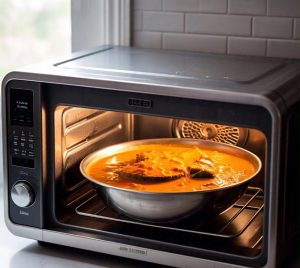Metal is a material composed primarily of atoms that readily lose electrons to form positive ions and have metallic bonds.
The question here is whether you can put metal in a microwave or not.
This article delves into the specifics of what happens when metal is placed inside a microwave, if it’s safe to do so, and what effects microwaving could have on different types of metals. We will discuss the scientific principles behind these reactions such as the reflection of microwaves by metals and the potential risks involved including sparking or damaging your microwave device. Furthermore, we will provide alternatives for heating food without using metals inside a microwave oven along with safety tips and precautions to follow while using your kitchen appliances. Frequently asked questions regarding this subject are included towards the end followed by our final word.

Jump To:
Is it Safe to Put Metal in the Microwave?
No, it is not safe to put metal in a microwave. Microwaves work by producing electromagnetic waves which generate heat when they come into contact with food items, but these waves reflect off metals causing sparks or even fires. Other materials like glass or plastic have different properties and behave differently within the microwave context. Hence, avoid using metallic objects or utensils with metallic elements while microwaving your food for safety reasons.
Facts About Metal in the Microwave
Here, we will discuss the important things to note about metal when it’s placed inside a microwave.
- Reflection of Microwaves: Metals reflect microwaves which can cause arcing and potentially start a fire.
- Damage to the Oven: Small pieces of metal or foil can damage the oven walls or even the magnetron that produces microwaves.
- Safety Concerns: Certain metals generate sparks that could lead to safety hazards including fires if not carefully monitored.
- Metal Thickness: Thin pieces of metal like aluminum foil are usually more dangerous than thicker pieces because they may not handle the heat generated by microwaves as effectively.
- Metal Shape and Size: Some shapes (like smooth round shapes) might be safer than others. Sharp edges on metals increase the risk of sparking (arcing).
We have discussed some facts about putting metals in a microwave.
Now, let’s move on to specific cases involving different types of metals being microwaved.
What are the Alternatives to Microwaving Metal?
The alternatives to microwaving metal include using conventional ovens, stovetops, grills or toaster ovens. These methods provide heat through convection and radiation which can be evenly distributed around the object. For instance, cooking utensils made from metal such as pans or pots can be safely used on a stovetop without any risk of sparking or damage.
Tips to Microwave Metal
While you should never put metal in microwave, these are the instructions to follow if you must:
- Never put thin metals like aluminum foil in the microwave.
- Make sure all objects placed inside are microwave-safe.
- Avoid placing sharp-edged metallic items as they could cause sparks.
- Always place food directly onto a glass or ceramic plate instead of metallic trays.
- If you’re unsure whether an item is safe for the microwave, opt for heat-resistant plastic containers as an alternative.
Now we will discuss FAQs in the next section.

Frequently Asked Questions (FAQs)
In this section, we will delve into some of the most frequently queried topics related to microwaving and heating various materials.
Can metal go in a microwave?
No, metal should not be put into a microwave. Microwaves emit electromagnetic waves that bounce off metal objects, causing sparks and potentially damaging your appliance. The same principle applies to aluminum foil or any other type of metallic kitchenware.
Is it safe to put glassware in a microwave?
Yes, it is generally safe to put glassware in a microwave. However, ensure that the glassware is labeled as “microwave-safe” because glasses with metallic paints can cause sparks similar to metals when heated under high-frequency radio waves from the microwave.
Can you heat plastic in a microwave?
In general yes, you can heat plastic containers in a microwave but they must be marked as “microwave-safe”. Not all plastics are created equal; some may release harmful chemicals when exposed to the intense heat generated by microwaves thus always check for appropriate labeling.
What about ceramic dishes in microwaves?
Ceramic dishes are typically safe for use in microwaves provided they’re labeled as such. Like glass and certain plastics though, ceramics without specific ‘microwave-safe’ indications could contain materials that might react adversely under micro-wavelength radiation from your appliance.
We hope these answers have clarified common concerns about what types of material you can safely heat using your microwave oven.
Final Word
Microwave ovens offer us convenience by significantly reducing food preparation times. To maximize safety while enjoying these benefits though, properly understanding which utensils can or cannot be used in a microwave is crucial. In general, only use materials that are labeled as “microwave-safe”. Avoid metals at all costs and be cautious with plastics unless they’re marked suitable for microwaving.



